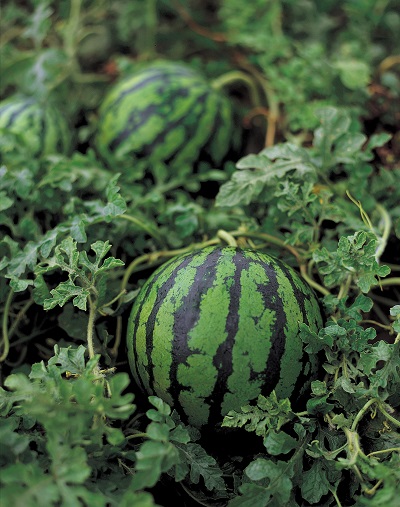
In the long, hot days of July and August, there is nothing quite as refreshing as a cool slice of watermelon. It is a summertime treat enjoyed by young and old alike. Watermelons are an ancient fruit whose culture is believed to date back to almost prehistoric times in the Mediterranean and northern Africa. Today, the watermelon remains a favorite crop among home gardeners. While watermelons are not a particularly difficult fruit to grow, there are some basics that every gardener should know to produce their best possible watermelon crop.
Watermelons are a fruit that require a long growing season, limiting its culture to areas that receive at least 80 to 100 consecutive days of very warm summer temperatures, at least 80 degrees Fahrenheit. Watermelons also favor warm nighttime temperatures. Anything below 60 degrees Fahrenheit is undesirable and 70 degrees or higher is preferred. For gardeners who live in areas with shorter summers, smaller icebox size melons will grow best, because they mature relatively quickly, usually in 75 days as compared to the 90 to 100 days of heat required for larger melons.
Generally, watermelons should not be planted outside until about two weeks after the last expected frost date. This will allow enough time for the soil to be thoroughly warmed before planting. To get a head start on your melon crop, try starting your seeds indoors or in a greenhouse. You don’t want to start watermelon seeds too early; typically they should be started indoors on or about a week before the date of the last expected frost in your area. When it comes time to move the transplants outdoors, be sure to plant them with adequate spacing. Typically, watermelon plants should be spaced no closer than one plant every three feet, though you may need even more space for varieties that produce larger melons.
If you choose to start your watermelon seeds in the garden, planting in hills is recommended. Plant two or three seeds in a mound of dirt, and once the plants are a couple inches tall, thin them to one plant per hill.
Getting watermelon plants started is usually easy, and once they take hold, the plant will grow rapidly. Knowing when to harvest them is the most difficult part of growing watermelons. Judging a ripe watermelon is something that has befuddled gardeners for centuries. There are many claimed tricks for gauging a fruit’s ripeness. Some say you should tap or knock on the fruit and listen for the sound produced. This is a less than perfect method, because the melon will make a ringing sound when it’s still too green, and the noise will promptly change over to a dull thud when it’s overripe. Other gardeners look for the small tail on the melon to turn brown and dry up. This can also be unreliable, because in some melon varieties, the stem dries up as much as a week before the fruit is fully ripened.
In general, the outer appearance of the melon is your best guide. Melons usually become less shiny and darker in color when fully ripened. Also check the underside of the fruit. The spot that the watermelon rests on will become more golden yellow in color when the fruit is ripe. If all else fails, plant a variety like Sugar Baby, a melon whose green stripes darken to near black when ripe, an unmistakable sign that it’s time to pick the fruit.
When it comes to successful culture of watermelons at home, one thing is for sure: it’s more of an art than a science. If your first attempt at homegrown melons doesn’t go well, don’t get discouraged and give up. Try a new variety the next year and you may have more luck. Remember, experience is the best teacher, and especially so when it comes to growing your best watermelons.
Ellen Bell works for a retail website that offers many home and garden products.
Related Articles & Free Email Newsletter
A Beginners Guide to Growing Vegetables in a Greenhouse
Growing Healthy, Productive and Profitable Plants through Succession Planting


Comment here